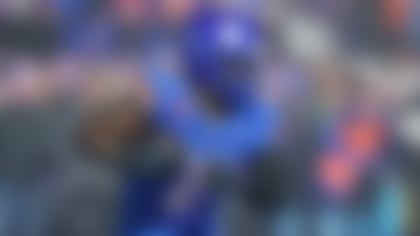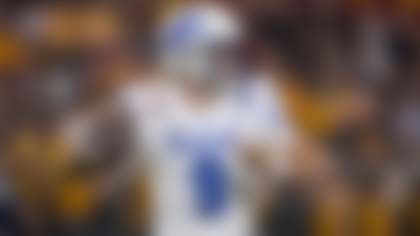Why provide instant grades on the selections of prospects who have yet to take an NFL snap? Well, you're reading this, aren't you? Considering the makeup of every roster and the factors surrounding each pick, Gennaro Filice and Nick Shook attempt a division-by-division assessment of the 2018 NFL Draft. Below is Gennaro's review of the NFC South.
NOTABLE SELECTIONS
BEST PICK: D.J. Moore, WR, Maryland
Carolina Panthers, Round 1, No. 24 overall
The Panthers landed the best receiver in this draft, and his Golden Tate-like game perfectly complements the existing weaponry in Cam Newton's arsenal. Devin Funchess and Greg Olsen are big-bodied targets, trade acquisition Torrey Smith takes the top off the defense, and Christian McCaffrey is a mismatch nightmare underneath. The 6-foot, 210-pound Moore, whose explosive athleticism was on full display at the NFL Scouting Combine, brings inside-outside versatility and special ability with the ball in his hands. Cam sent Ron Rivera a "thank you" text following the pick, and it's easy to see why. Just ask franchise icon Steve Smith Sr., who offered some choice words after Moore's selection: "They have *never* been able to replace me ... until today."
MOST SURPRISING PICK: Marcus Davenport, DE, UTSA
New Orleans Saints, Round 1, No. 14 overall
When the Saints gave away next year's first-round draft pick in a trade that catapulted them up 13 spots, every football lover in America began fantasizing about a Lamar Jackson-Sean Payton marriage. Yeah, the price was steep, but if that were the cost of planning for life after Drew Brees, Saints fans would be able to stomach it. The potential of acquiring a franchise QB-in-waiting -- one who just so happens to be a breathtaking playmaker -- allows for spendthriftiness. That's not what the Saints did, though, instead mortgaging their future on a pass rusher -- and a raw one, at that. Davenport may very well develop into a premier quarterback hunter in time, but it's unfair to count on the small-school product to embody the missing piece in 2018. Unfortunately, that's the expectation that spawns from such an aggressive draft maneuver.
BIGGEST SLEEPER: Ian Thomas, TE, Indiana
Carolina Panthers, Round 4, No. 101 overall
Here's a player who's fun to root for, because his journey to the NFL's inspiring and his raw skill set's awe-inspiring. Thomas lost his mother to kidney failure and his father to a heart attack -- all before he even turned 10 years old. Raised by older siblings, Thomas hit Nassau Community College as a basketball prospect, but ended up on the gridiron and eventually earned a scholarship to Indiana. His numbers from last season (25 catches for 376 yards and five touchdowns) don't blow you away, but injuries limited his play. This is an upside play -- one I can get into. Thomas' size (6-4, 259 pounds), athletic traits and basketball background breed comparisons to Antonio Gates. FYI: Norv Turner, who served as head coach of the Chargers during five of Gates' eight Pro Bowl seasons, is now the offensive coordinator in Carolina.
TEAM GRADES
NOTE: Draft classes are ranked from best to worst within the division.
» Round 1: (No. 26 overall) Calvin Ridley, WR, Alabama.
» Round 2: (No. 58) Isaiah Oliver, CB, Colorado.
» Round 3: (No. 90) Deadrin Senat, DT, South Florida.
» Round 4: (No. 126) Ito Smith, RB, Southern Miss.
» Round 6: (No. 194) Russell Gage, WR, LSU; (No. 200) Foye Oluokun, LB, Yale.
Thomas Dimitroff's pretty good at his job. Since 2008, the year the Falcons hired New England's director of college scouting to take over as their general manager, Atlanta owns a 95-65 record -- the fourth-best mark in the NFL, trailing only the Patriots, Steelers and Packers. That's a testament to Dimitroff and Co.'s draft-and-develop proficiency. Starting with his very first draft pick in Atlanta (Matt Ryan), Dimitroff's displayed a keen eye for talent. Inherently, this has always been a homegrown roster. According to Pro Football Focus, the Falcons logged the fifth-most homegrown snaps in 2017. This is all a preamble to an unsurprising opinion of this draft haul: I like it. Ridley might not be a WR1 at this level, but he doesn't need to be one in Atlanta, lining up next to Julio Jones and Mohamed Sanu. Oliver brings the traits Dan Quinn desires in a corner: length, athleticism and ball skills. The Falcons have a type at defensive tackle, too: Senat's eerily similar to Grady Jarrett, as a short, stout, interior disruptor who routinely wins the leverage game. And Smith is a highly productive back who's very comfortable in the passing game -- forward-thinking insurance should Tevin Coleman walk in free agency next offseason. Again, Thomas Dimitroff's pretty good at his job.
» Round 1: (No. 12 overall) Vita Vea, DT, Washington.
» Round 2: (No. 38) Ronald Jones II, RB, USC; (No. 53) M.J. Stewart, CB, North Carolina; (No. 63) Carlton Davis, CB, Auburn.
» Round 3: (No. 94) Alex Cappa, OG, Humboldt State.
» Round 4: (No. 117) Jordan Whitehead, S, Pittsburgh.
» Round 5: (No. 144) Justin Watson, WR, Pennsylvania.
» Round 6: (No. 202) Jack Cichy, LB, Wisconsin.
Like every other sentient being, I assumed Tampa Bay would take Derwin James at No. 7 overall. The Swiss Army Knife safety out of Florida State would give the Buccaneers' secondary some needed juice, I figured. And he wouldn't even have to set foot on a plane to relocate from Tallahassee to Tampa. He'd actually be moving much closer to his hometown of Haines City, Florida! So, yes, I was a bit surprised when the Bucs traded down. And I was utterly stunned when Jason Licht opted for Vea over James at No. 12. But as the draft played out, I came to appreciate Licht's master plan ... despite the fact that I do believe Tampa could regret passing on James. The 2017 Buccaneers' defense was horrendous any way you cut it. Tampa Bay finished dead last in new-school stats ( DVOA) and old-school stats ( total defense). Come together, millennials and traditionalists -- you both know this unit was terrible. Licht clearly saw the D-line as the chief culprit, acquiring Jason Pierre-Paul, Vinny Curry, Beau Allen and Mitch Unrein in March, before adding the first-round cherry on top: an agile, 347-pound behemoth by the name of Tevita Tuli'aki'ono Tuipulotu Mosese Va'hae Fehoko Faletau Vea. With the pair of second-round picks obtained in the trade down to 12, Tampa infused its secondary with some of that needed juice referenced above, adding Stewart and Davis to the CB mix. Given all the intriguing new faces across the defense, it's easy to imagine significant improvement in 2018. That's the hope with the run game, too. Tampa spent its other two premium picks on a big-play running back (Jones) and a mauling guard (Cappa). All in all, Licht hit a number of need areas. Touche. Still think Derwin would've looked mighty nice in pewter, though.
» Round 1: (No. 24 overall) D.J. Moore, WR, Maryland.
» Round 2: (No. 55) Donte Jackson, CB, LSU.
» Round 3: (No. 85) Rashaan Gaulden, S, Tennessee.
» Round 4: (No. 101) Ian Thomas, TE, Indiana; (No. 136) Marquis Haynes, Edge, Mississippi.
» Round 5: (No. 161) Jermaine Carter, LB, Maryland.
» Round 7: (No. 234) Andre Smith, LB, North Carolina; (No. 242) Kendrick Norton, DT, Miami.
There was no Julio Jones or A.J. Green in this draft. (Man, that 2011 draft ... The first round's draft porn -- unless you took a quarterback not named Cam Newton.) But there was a catch-and-run wizard with a running back's bulk, a slot's agility and an outside receiver's long speed. Moore's a six-foot package of playmaking -- really a thrill to watch in the open field. Eclipsing the 1,000-yard mark in his final season at Maryland was no small feat, given how cursed/crummy Terp quarterbacks were during Moore's time in College Park. Another juicy pick: The very first player off the board on Day 3. With just one year of high-level starting experience under his belt, Thomas needs more gridiron reps. But the 6-4, 259-pounder's raw athletic traits are easy to see -- and en vogue at the tight end position. Those two picks were sandwiched around a pair of secondary reinforcements: Jackson can run really, really, ridiculously fast -- as he displayed in 4.32 seconds at the combine -- while Gaulden's more of a technician who could excel as a big nickel corner. The biggest problem I see with this draft class is that I don't see any offensive linemen.
» Round 1: (No. 14 overall) Marcus Davenport, DE, UTSA.
» Round 3: (No. 91) Tre'Quan Smith, WR, UCF.
» Round 4: (No. 127) Rick Leonard, OT, Florida State.
» Round 5: (No. 164) Natrell Jamerson, S, Wisconsin.
» Round 6: (No. 189) Kamrin Moore, CB, Boston College; (No. 201) Boston Scott, RB, Louisiana Tech.
» Round 7: (No. 245) Will Clapp, C, LSU.
The Saints were essentially in the NFC title game ... Then Marcus Williams' brain froze, allowing Minnesota to perform a miracle. So, it's not hard to understand why Mickey Loomis, Sean Payton and Co. would be tempted to go hard after an edge rusher to push them over the top. But this report card says they went too hard. Far too hard. Caution, meet wind. In today's NFL, giving up a future first-rounder is rare. This isn't the NBA. These babies are the Berkshire Hathaway stock of the NFL draft market. Typically, teams only give 'em up for quarterbacks. And shoot, four teams actually did trade up to snag a first-round QB in this draft -- nary a one forfeited a future first-rounder. So it was indeed shocking to see New Orleans sacrifice a 1 for an unfinished non-quarterback. Could Davenport immediately take the league by storm, pile up sacks in bunches and fire this grade into the sun? Stranger things have happened. But to me, the probability of such a reward just wasn't worth this risk. Payton comparing New Orleans' reckless abandon to the national debt isn't helping. I could provide some quick analysis on the remaining picks -- Tre'Quan's turbo-charged lankiness is cool! -- but let's be honest: This grade's all about the first-round head-scratcher.
Follow Gennaro Filice on Twitter @GennaroFilice.
















